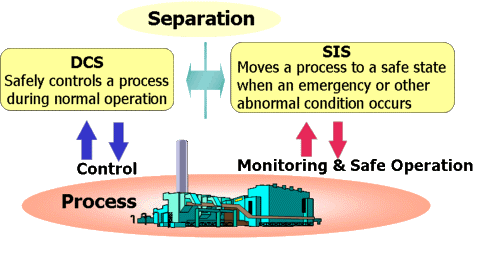The following are the Safety Instrumented Systems (SIS) Quiz Questions and Answers.
Safety Instrumented Systems (SIS) Quiz

- Which of the following is the best definition of a Safety Instrumented System?
a. A control loop whose failure may result in the initiating of a chain of events
that could result in a hazardous outcome
b. Any instrumentation function that is related to process safety, such as a
critical alarm or a manually activated shutoff switch
c. A programmable logic controller that is dedicated to safety functionality
d. An instrumented control system that detects “out of control” conditions and
automatically returns the process to a safe state
Show Answer
Answer: d
- Which of the following is the best definition of a safety instrumented function?
a. All the safety functionality contained in a safety instrumented system
b. A function that is implemented by an SIS that is intended to achieve or
maintain a safe state for a process with respect to a specific hazardous
event
c. A safety certified instrument
d. All basic process control loops whose failure could result in a safety consequence
Show Answer
Answer: b
- Most national regulations for process safety require which of the following as a
means to achieve functional safety of SIS?
a. Adherence to Recognized and Generally Accepted Good Engineering
Practice
b. Use of third party certified equipment and engineering resources
c. Development of prescriptive procedures by each individual operating
company with submittal of the procedures for licensure
d. Most regulations for process safety do not consider functional safety of SIS
Show Answer
Answer: a
- Which of the following is a causal factor where poor SIS design resulted in, or
contributed to a process safety incident?
a. Improper isolation procedures were used to isolate pipe segments prior to
welding
b. Poor permitting procedures resulted in sources of ignition in an area where
flammable materials were stored
c. Poor basis for when safety should be automated as opposed to allowing
operator actions as the sole means of safeguarding
d. Failure to measure oxygen concentration before entry into a confined space.
Show Answer
Answer: c
- In accordance to IEC 61511, how must verification that a safety integrity level
has been achieved by performed?
a. Qualitatively
b. Quantitatively
c. Using third party certifications
d. Using standard design guidebooks
Show Answer
Answer: b
- Which of the following activities, as defined in the IEC 61511 safety lifecycle,
occurs throughout the entire lifecycle of a SIS?
a. Hazard and Risk Assessment
b. Safety Requirements Specification
c. Operation and Maintenance
d. Management of Functional Safety and Functional Safety Assessment and
Auditing
Show Answer
Answer: d
- Which range of average probability of failure on demand corresponds to SIL 1?
a. 1% to 10%
b. 0.1% to 1%
c. 0.01% to 0.1%
d. 0.001% to 0.01%
Show Answer
Answer: a
- Which of the following is not an independent protection layer?
a. Preventive Maintenance
b. Operator Intervention Based on Alarms
c. Relief Valves
d. Check Valves
Show Answer
Answer: a
- Which of the following is the best description of Target Maximum Event
Likelihood?
a. The maximum frequency at which an SIS should be activated
b. The maximum frequency of failure on non-SIS safeguards
c. The maximum frequency at which a control system failure can occur
d. The maximum frequency at which an event of a given consequence
magnitude is tolerable
Show Answer
Answer: d
- Which of the following items can most appropriately be described in a safety
requirements specifications general note?
a. Process safety time for a SIF
b. Sensor measurement set point
c. Philosophy for separation of basic process control and safety control
d. Valves that are closed when a process switch indicates an out of control
condition
Show Answer
Answer: c
- Which is the most common form of logic description in safety requirements
specifications?
a. Text Narrative
b. Cause-and-Effect Diagrams
c. Sequential Function Charts
d. Binary Logic Diagrams
Show Answer
Answer: b
- Achievement of higher SIL levels (2 and 3) often require some degree of
tolerance to dangerous failures which is provided by more advanced voting
schemes like 1oo2 or 2oo3 voting.
a. True
b. False
c. Not discussed in the IEC 61511 standard
d. Not application to safety instrumented systems
Show Answer
Answer: a
- More frequent testing results in lower average probability of failure on demand
and higher achieved SIL because?
a. Better maintained instruments fail less frequently
b. The average amount of time that a device is in the failed state decreases
c. Improved auditing results in less scrutiny from regulatory agencies
d. When a device is bypassed in order to allow a test to occur it is not capable
of causing a spurious shutdown
Show Answer
Answer: b
- If a SIS instrument is bypassed for any reason, and that device is the sole means
of bringing the process to a safe state if the SIF were to be activated by a
process loss-of-control (i.e., no redundancy), what documentation needs to be
prepared in order to allow the process to operate safely while the device is
bypassed?
a. Bypass Risk Assessment
b. Management of Change
c. Alternate Protection Plan
d. Bypass Authorization Form
Show Answer
Answer: c
- What is the most critical attribute of a proof test of an SIS component?
a. Any known dangerous failure mode that is undetectable by automatic
diagnostics would be detected
b. The test is executed in the presence of the equipment vendor
c. The test procedure is provided by a SIL certified equipment vendor
d. The test uses automated tools that are connected to a computerized
maintenance management system (CMMS)
Show Answer
Answer: a
Source: kenexis